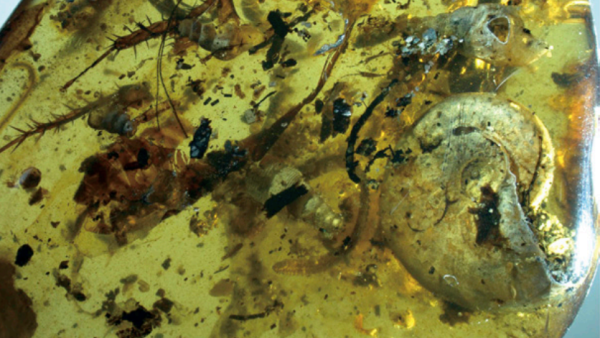Ambers usually contain creatures that live in ground areas. However, a joint research team from the Chinese Academy of Sciences (CAS) and the Indiana University (IU) found an extinct sea organism locked in a 99-year-old amber piece.
Amber or resin is produced by coniferous trees after incisions to protect themselves from diseases. The secreted substance traps the organisms living on the tree.
Amber pieces often contain insects such as spiders, cockroaches, beetles, flies and wasps, most of which live in desert areas. But the amber piece studied by the US-Chinese research team was unique as it contained an ammonite, an extinct marine invertebrate. The study was published on Monday in the PNAS journal.
The distinct 99-million-year-old amber piece was found in northern Myanmar; it is 33 mm long, 9.5 mm wide, 29 mm high and weighs 6.08 g.
The researchers used X-ray micro-computed tomography (micro-CT) to obtain high-resolution three-dimensional images of the ammonite including its convoluted sutures, which are important for identifying ammonites.
David Delcher from the IU's department of geology, and the study lead author wrote in a report published by CAS: "We managed to determine the type of the ammonite. It is a Puzosia (Bhimaites) with a mucous membrane, but the amber was broken and filled with sand."
{"preview_thumbnail":"https://cdn.flowplayer.com/6684a05f-6468-4ecd-87d5-a748773282a3/i/v-i-f…","video_id":"fb0090c1-bddf-4097-9ae0-779322b9c938","player_id":"8ca46225-42a2-4245-9c20-7850ae937431","provider":"flowplayer","video":"60 Palestinians Wounded by Israeli Attacks in Nakba Day Protests"}
Talking about the discovery, Delcher said: "The most likely explanation for the appearance of both marine and terrestrial organisms within the amber is that a sandy beach covered with shells was located close to amber-producing trees. The flying insects were trapped in the amber while it was still on the tree. As the amber flowed down the tree trunk, it trapped organisms that lived near the foot of the tree. Reaching the beach, it entombed shells and trapped the marine organisms living there."
"This is the first record of ammonite in amber," Dr. Bo Wang from Nanjing Institute of Geology and Palaeontology said, adding that "this precious piece has been displayed at the Lingpoge Amber Museum, Shanghai, China due to its unique historical and scientific value."
"The piece proves that amber trees were located near a dynamic and changing coastal environment, and represents a fossil record of the geological age dating back to 99 million years.
This article has been adapted from its original source.








